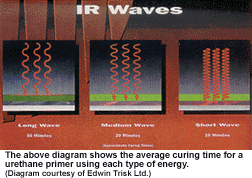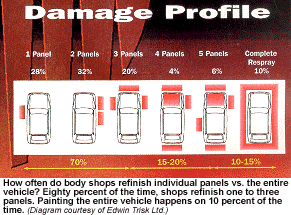With the use of infrared in body shops on the rise, it’s interesting to look back and see how and why its use has grown so quickly and what the future holds for this piece of equipment.
What Is Infrared?
Infrared is a type of radiation or energy given off by objects that have a temperature above 0 degrees C. The hotter the object, the more energy it gives off and the more intense that energy becomes. An extreme example would be the sun, which can transfer its energy to a distance of 93 million miles. Interestingly enough, it’s not heat that’s being transferred; it’s only when this type of energy comes in contact with an object that the production of heat occurs.
All objects are comprised of molecules, and infrared radiation causes these molecules to excite. In this excited state, a type of vibration occurs, producing heat. Why do some objects feel warmer than others on a sunny day? Different objects have different molecular structures, and when they excite, they heat to different levels. Wood, metal, water and sand are materials that show these variations quite well. Touch or sit on a wooden bench and then a black metal car to feel the difference for yourself. (Dark colors help objects absorb this type of energy, making them hotter.)

Infrared Instead
The use of infrared in body shops caught on quickly not just because of fast curing times but because of its relatively low running cost, which is normally only a few pennies per job. The average body shop only paints the whole car 10 percent of the time, yet on every bake cycle, a large volume of heated air is produced to heat the entire vehicle, even for a repair the size of a basketball. Infrared, on the other hand, can be applied just where you need it on the painted panel.
Another benefit of infrared is depth of penetration. In the case of short-wave infrared, the heat produced at the substrate will also be high. So, in effect, you’re curing from the inside out — ensuring a fully cured coating. This total curing reduces the need for re-dos often caused by under-cured products below the topcoat continuing to cross-link. This can lead to loss of gloss, swirl marks, pin holing, adhesion problems and sometimes a halo around the repair area. These problems sometimes aren’t seen in the body shop, but once the vehicle is returned to the customer and exposed to the sun’s infrared rays, these problems can manifest.
Infrared curing also brings consistency. The same curing times can be produced on a day-to-day basis, something that can vary even in a spraybooth, depending on weather conditions. In some parts of the world, primers are left drying in open shop conditions, which can mean jobs are left standing for three or four hours and sometimes overnight. Short-wave infrared could have completed the same job in 15 minutes or less.
Infrared Equipment Options
The common types of infrared equipment fall into three basic categories:
- Mobile systems — Mostly found in prep areas, these units are relatively inexpensive and simple to use. The downside? Area coverage can be limited and some units are too big and cumbersome to move around in confined areas.
A common mistake made with infrared units involves the distance they’re used from the painted panel. Move in too close, and you may very well experience solvent popping in the paint job. Judging distance is fairly easy, and some mobile units currently being produced have built-in ultrasonic distance-measuring systems. You simply push the unit toward the repair and when the green light comes on, you’re at the correct distance. Some units will even think for themselves by switching off if you move too close.
- Large track systems — These systems can run on a suspended overhead rail in a single bay or between several preparation bays. This type of system has become popular with large shops. One benefit includes ease of use in restricted areas where a large mobile unit can experience problems. Another is that a main power feed is fed in from above, dispensing with trailing cables and extension cords.
In some countries, waterborne primers have become more common. Large track systems not only solve the drying problems associated with these coatings but also allow you to attach several infrared heads to give you a larger coverage area.

- Dedicated in-booth systems — This type of system must overcome the two problems experienced when putting equipment into a spraying environment: overspray and safety hazards. Most systems will have blinds, curtains or a safe house to curtail the overspray problem. But it’s not just the mess you have to worry about; it’s also the fact that overspray on reflectors will cause the equipment’s performance to deteriorate, since infrared rays are absorbed by the once-shiny surface of its reflectors, rather than being beamed toward the vehicle. The equipment must be made totally safe, and to do this, manufacturers install a purge system that won’t allow the infrared unit to switch on until all spraying fumes have been removed from the spraybooth.
Is Infrared for You?
More and more people are starting to appreciate what infrared equipment can do if used correctly in the body shop. And it’s not just for paint curing, which is the perception of many shop owners and techs. Using infrared before cleaning a plastic bumper brings release agents to the surface and using it prior to filler or primer applications helps remove any moisture present. It can even be used to remove humidity haze or blush from a topcoat.
When purchasing infrared equipment, it’s a good idea to see if the seller or manufacturer provides training. Many times, I’ve seen quality infrared equipment gathering dust in the corner of a body shop. Why? A painter messed up the first paint job he used it on because he hadn’t received the proper training. Once that happens, techs usually become nervous about using the unit. This should never happen. Thirty minutes is all it takes to learn the basics, and that little bit of time spent learning about infrared equipment will pay off time and time again.
Writer Peter L. Phillipson is the sales and marketing manager for Edwin Trisk Ltd.
|
Keep Things Rolling Along
One application technique that’s catching on globally is rolling on primer instead of spraying it. The average body shop tech will probably raise an eyebrow at this suggestion, but it’s proving to be an effective method on smaller priming jobs. The benefits of this application technique are interesting: no pollution of shop air or contamination of other vehicles, no wasted primer, no masking and no gun to clean. The catch is that it’s only effective when used in conjunction with short-wave infrared. Shops I’ve witnessed using this process in conjunction with infrared have increased their throughput by up to 30 percent. |













